Abstract
The epizootic range of Rift Valley fever in Kenya is defined from the results of virus isolations during epizootics, and form an extensive serological survey of cattle which were exposed during an epizootic. A study of the sera from a wide range of wild bovidae sampled immediately after the epizootic, showed that they did not act as reservoir or amplifying hosts for RVF. Virus isolation attempts from a variety of rodents proved negative. Rift Valley fever did not persist between epizootics by producing symptomless abortions in cattle in areas within its epizootic range. A sentinel herd sampled annually after an epizootic in 1968 revealed not one single seroconversion from 1969 to 1974. Certain forest and forest edge situations were postulated as enzootic for Rift Valley fever, and a small percentage of seroconversions were detected in cattle in these areas, born four years after the last epizootic. This has been the only evidence for the persistence of the virus in Kenya since 1968, and may be a part of the interepizootic maintenance cycle for Rift Valley fever in Kenya, which otherwise remains unknown.
Full text
PDF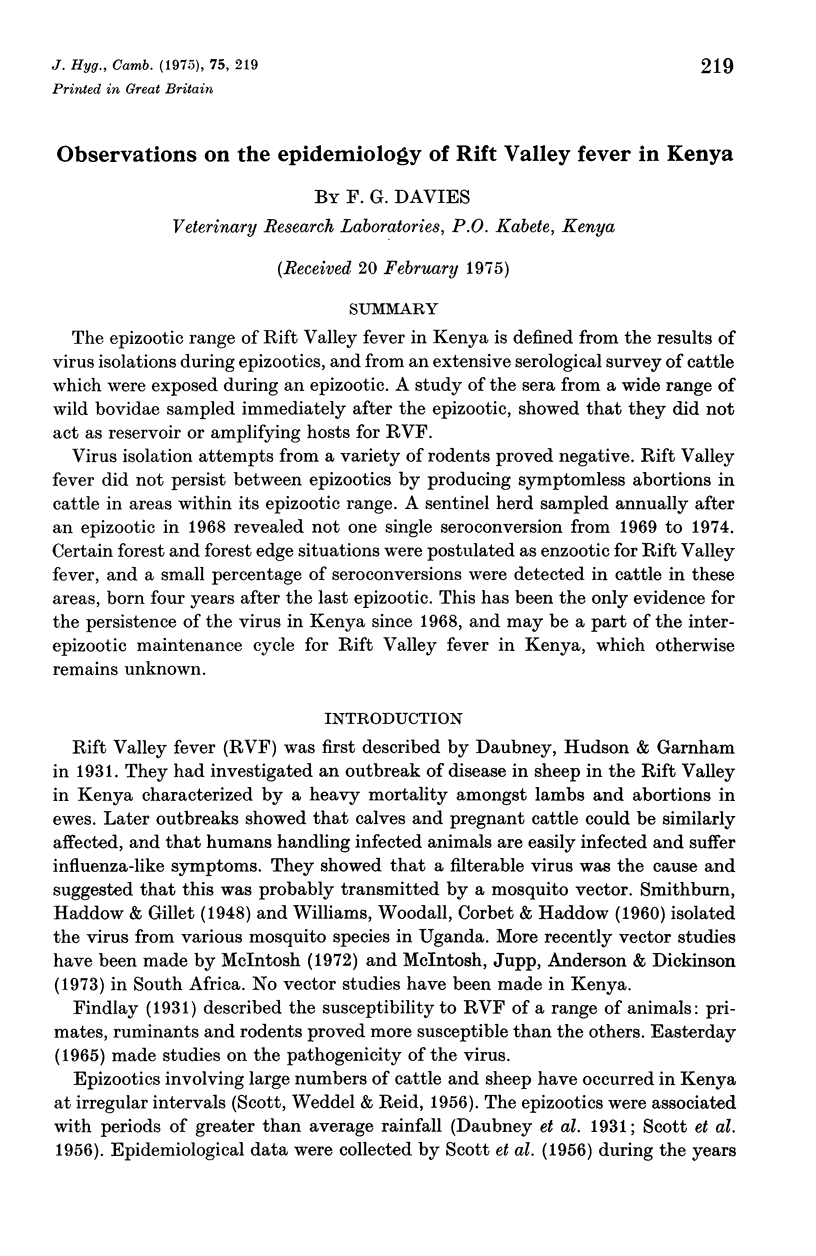
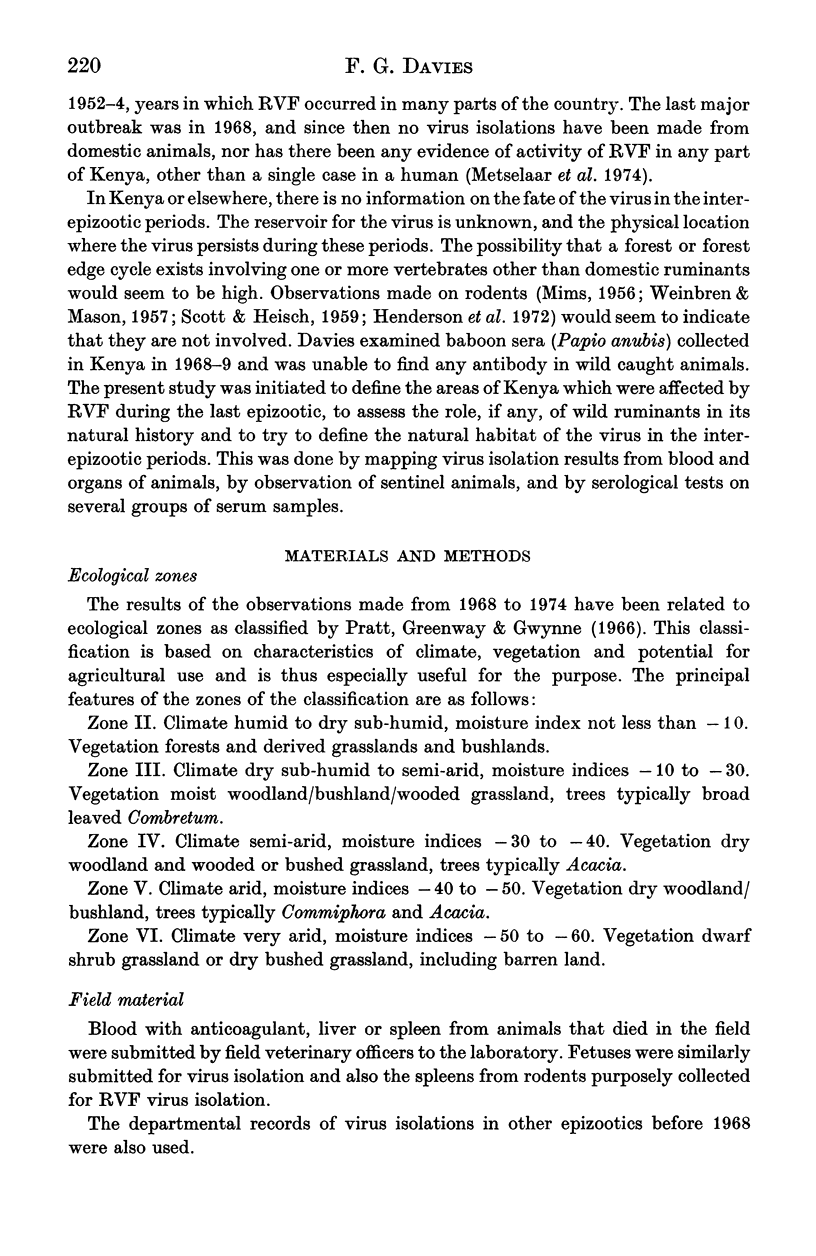
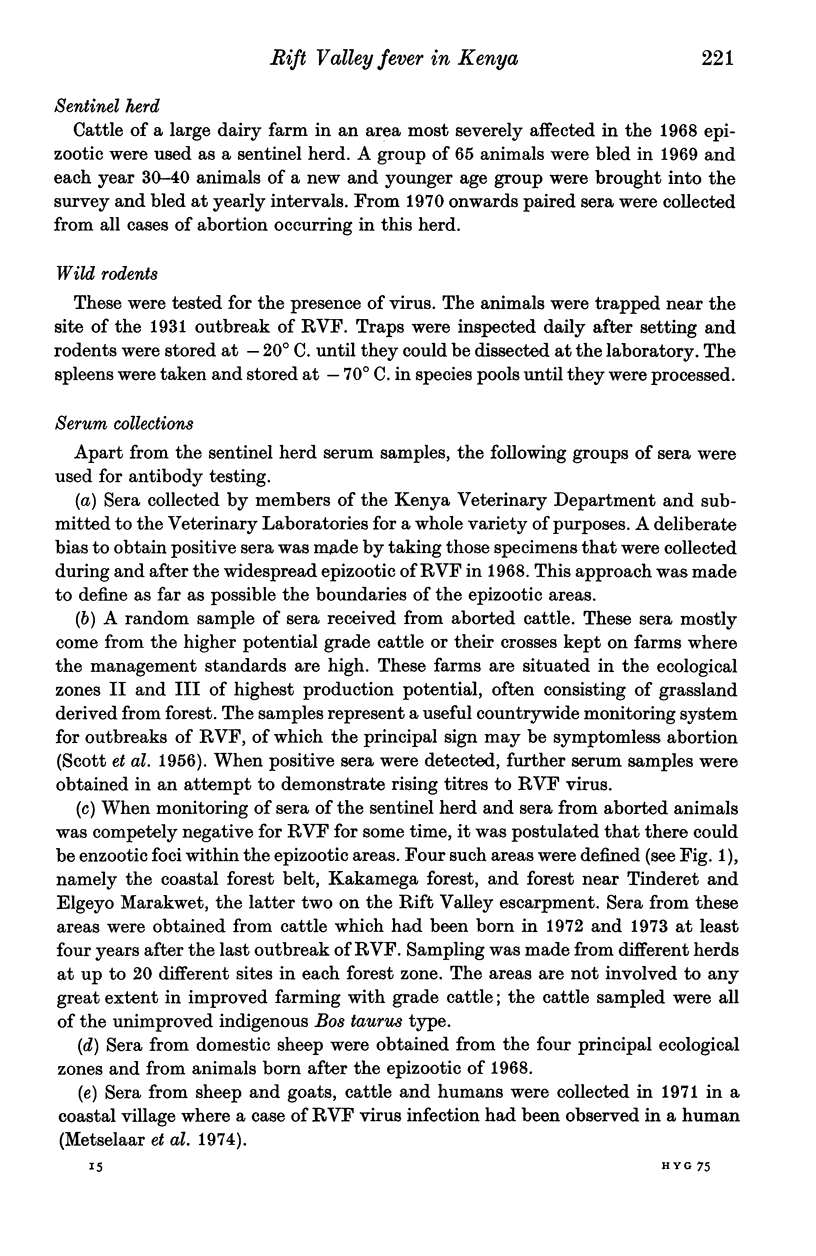
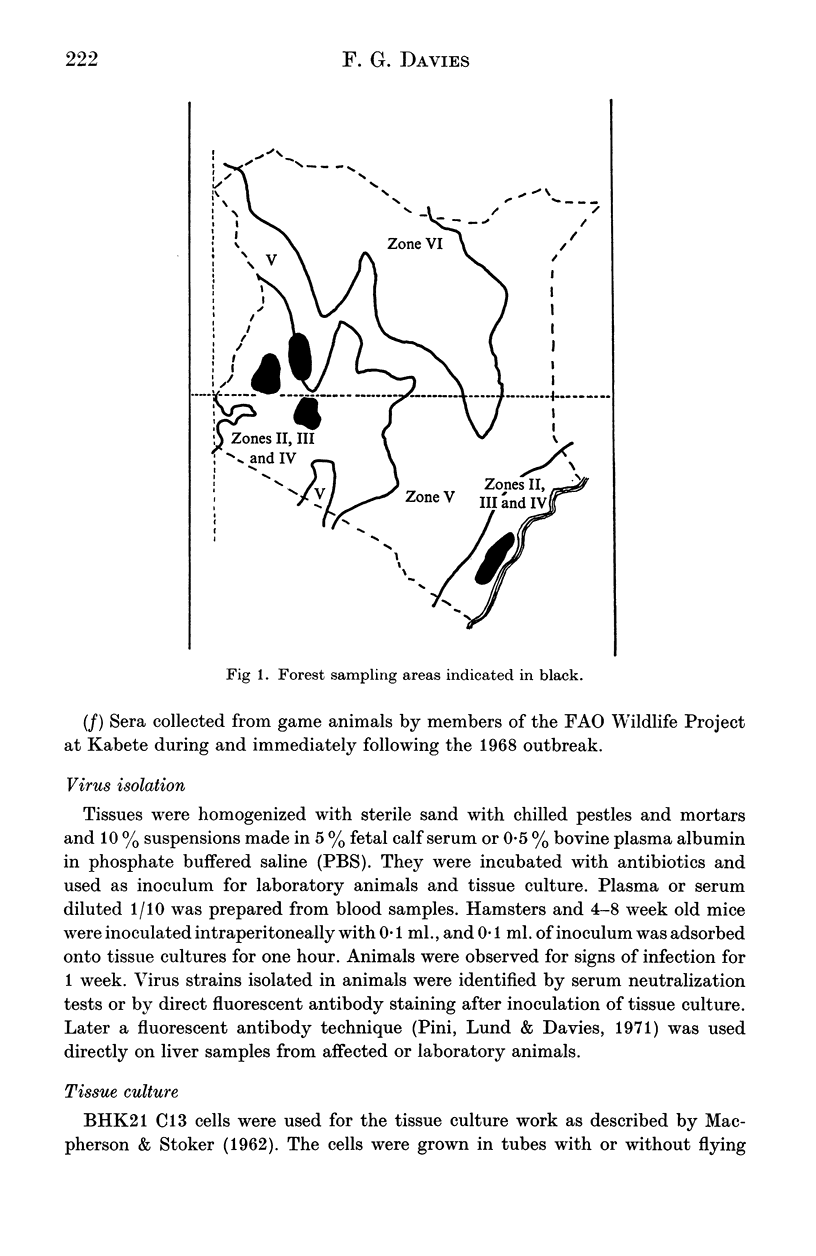
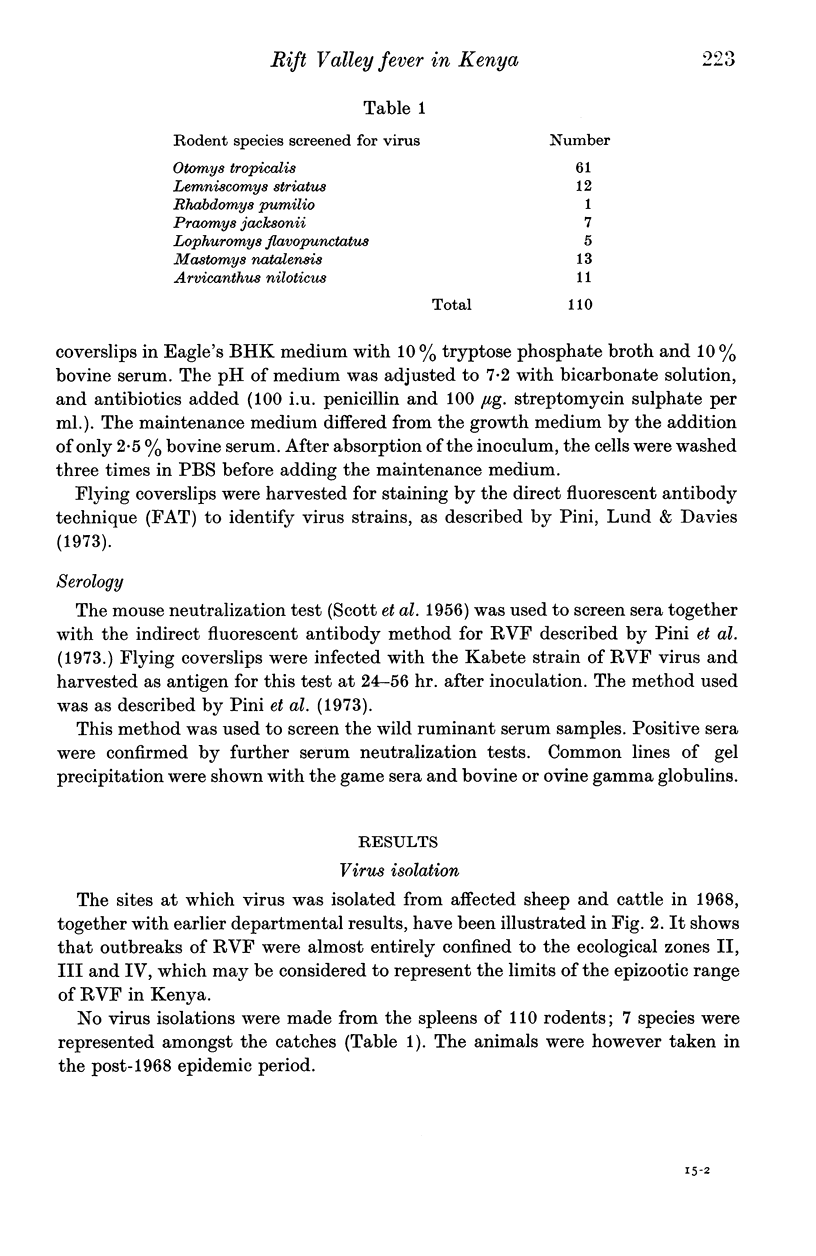
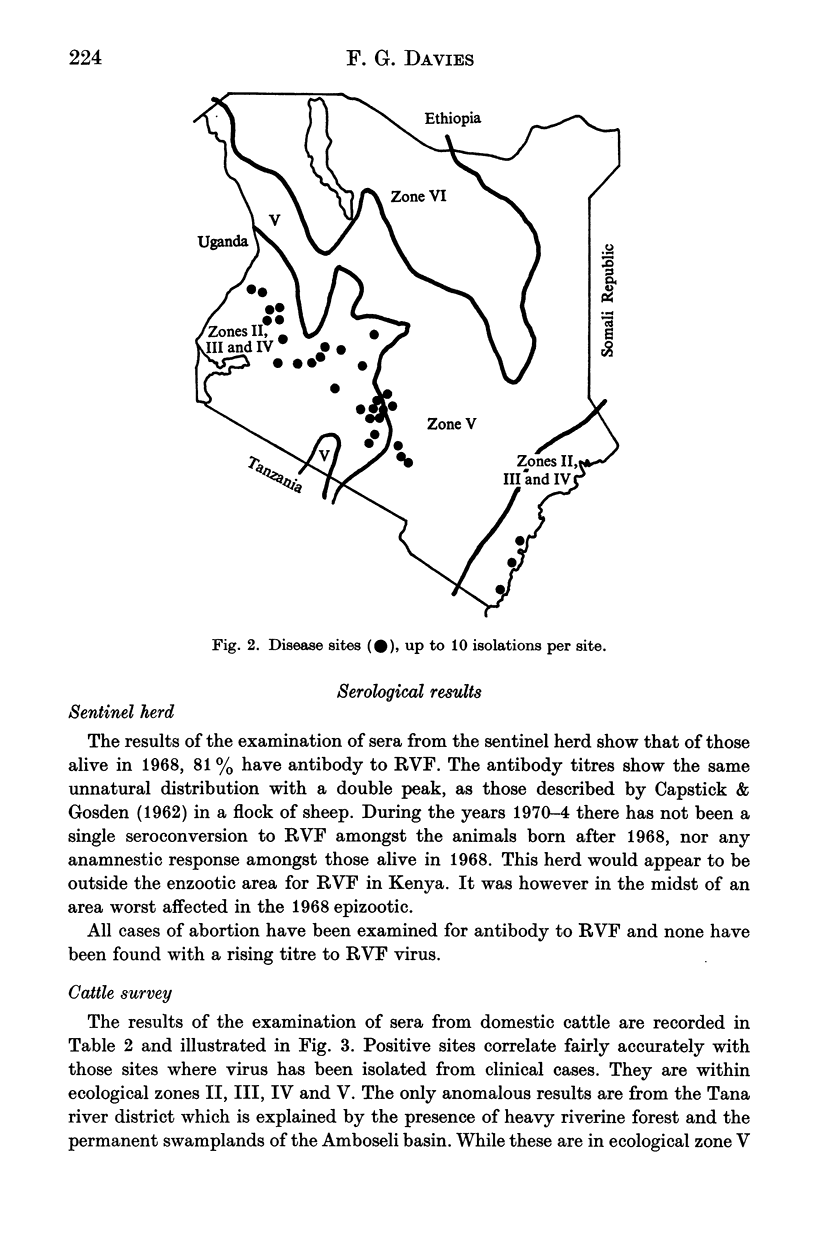
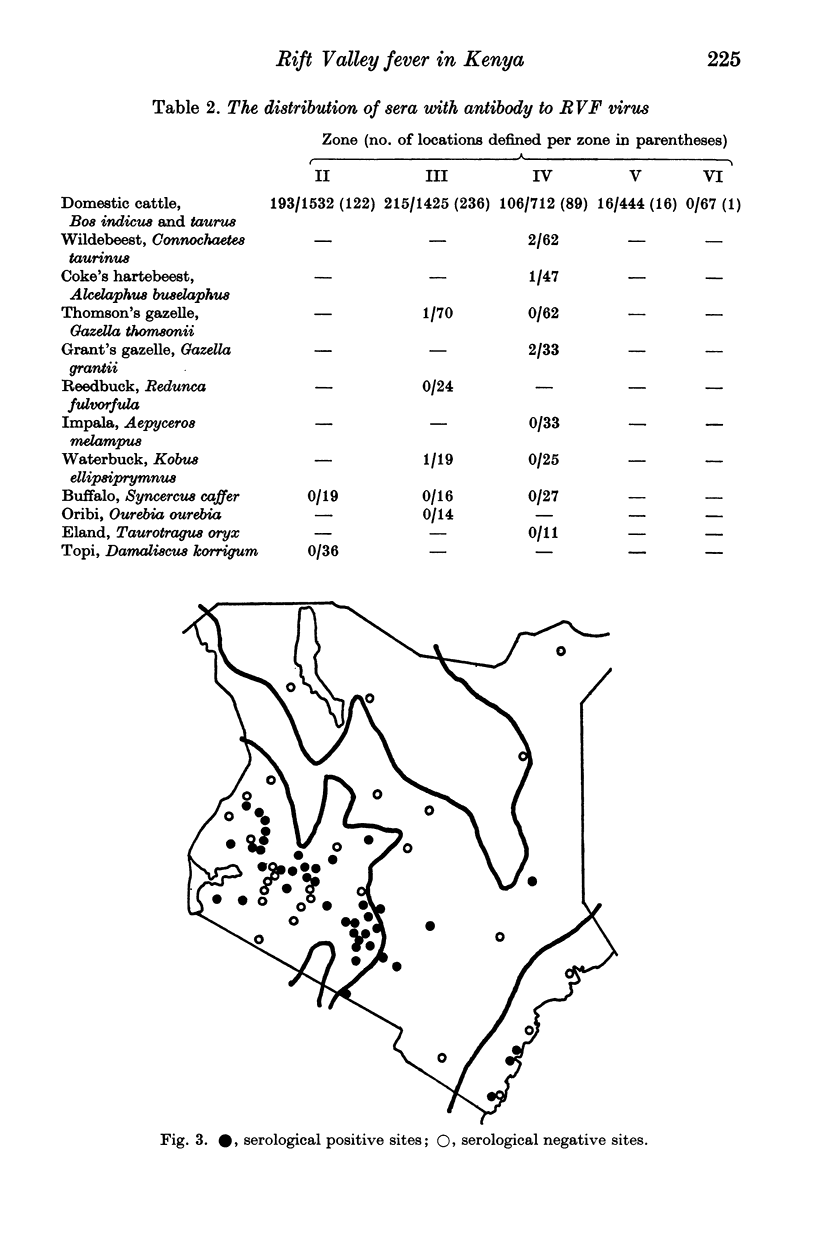
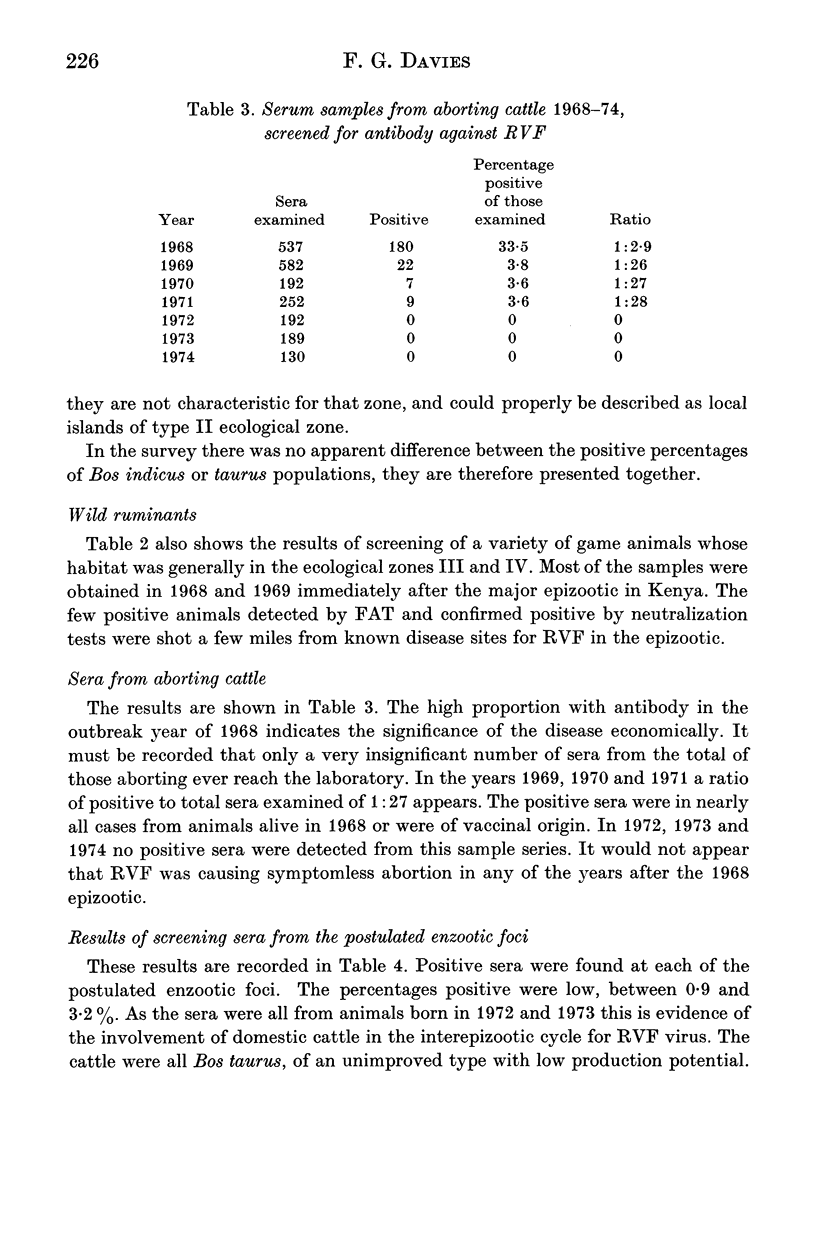
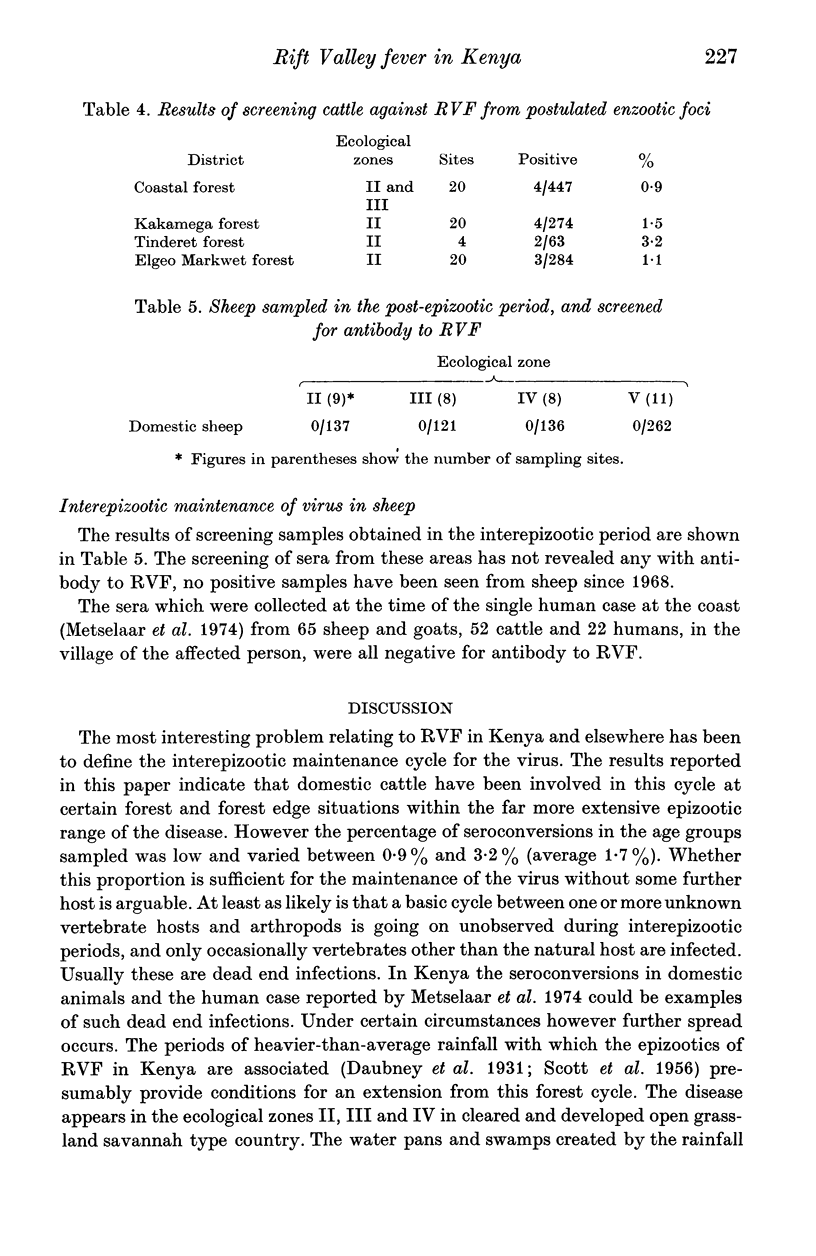
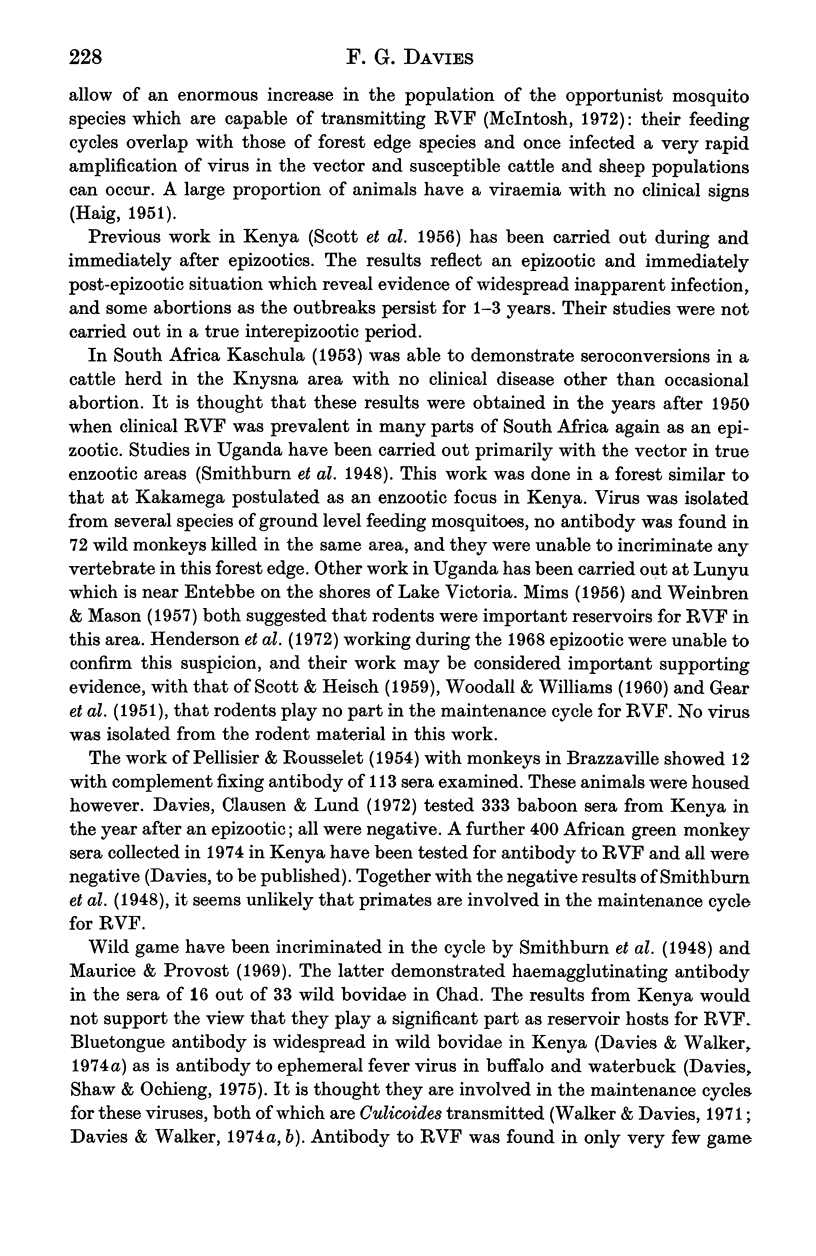
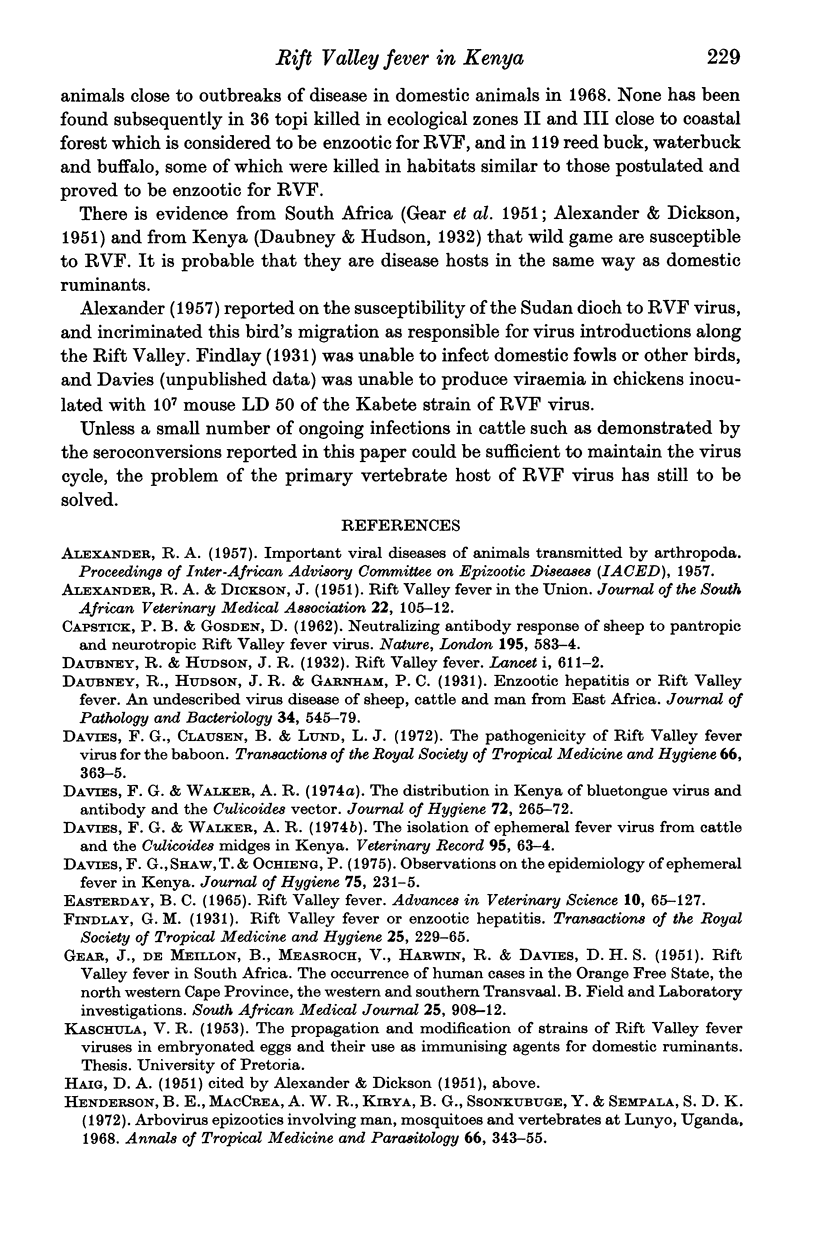
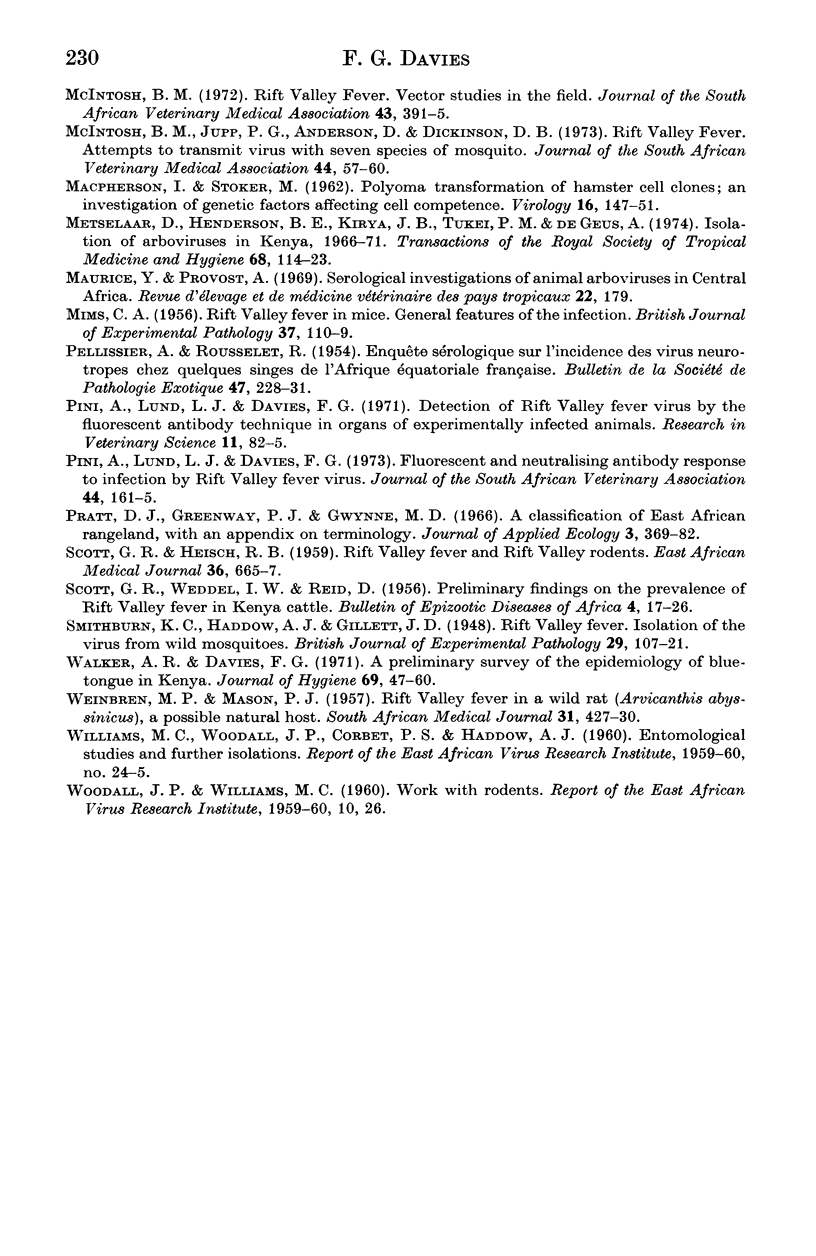
Selected References
These references are in PubMed. This may not be the complete list of references from this article.
- CAPSTICK P. B., GOSDEN D. Neutralizing antibody response of sheep to pantropic and neutrotropic rift valley fever virus. Nature. 1962 Aug 11;195:583–584. doi: 10.1038/195583a0. [DOI] [PubMed] [Google Scholar]
- Davies F. G., Clausen B., Lund L. J. The pathogenicity of Rift Valley fever virus for the baboon. Trans R Soc Trop Med Hyg. 1972;66(2):363–365. doi: 10.1016/0035-9203(72)90253-2. [DOI] [PubMed] [Google Scholar]
- Davies F. G., Shaw T., Ochieng P. Observations on the epidemiology of ephemeral fever in Kenya. J Hyg (Lond) 1975 Oct;75(2):231–235. doi: 10.1017/s0022172400047264. [DOI] [PMC free article] [PubMed] [Google Scholar]
- Davies F. G., Walker A. R. The distribution in Kenya of bluetongue virus and antibody, and the Culicoides vector. J Hyg (Lond) 1974 Apr;72(2):265–272. doi: 10.1017/s0022172400023470. [DOI] [PMC free article] [PubMed] [Google Scholar]
- Davies F. G., Walker A. R. The isolation of ephemeral fever virus from cattle and Culicoides midges in Kenya. Vet Rec. 1974 Jul 20;95(3):63–64. doi: 10.1136/vr.95.3.63. [DOI] [PubMed] [Google Scholar]
- Easterday B. C. Rift valley fever. Adv Vet Sci. 1965;10:65–127. [PubMed] [Google Scholar]
- GEAR J., DE MEILLON B., MEASROCH V., DAVIS D. H. S., HARWIN H. Rift valley fever in South Africa. 2. The occurrence of human cases in the Orange Free State, the North-Western Cape Province, the Western and Southern Transvaal. B. Field and laboratory investigation. S Afr Med J. 1951 Dec 8;25(49):908–912. [PubMed] [Google Scholar]
- Henderson B. E., McCrae A. W., Kirya B. G., Ssenkubuge Y., Sempala S. D. Arbovirus epizootics involving man, mosquitoes and vertebrates at Lunyo, Uganda 1968. Ann Trop Med Parasitol. 1972 Sep;66(3):343–355. doi: 10.1080/00034983.1972.11686834. [DOI] [PubMed] [Google Scholar]
- MACPHERSON I., STOKER M. Polyoma transformation of hamster cell clones--an investigation of genetic factors affecting cell competence. Virology. 1962 Feb;16:147–151. doi: 10.1016/0042-6822(62)90290-8. [DOI] [PubMed] [Google Scholar]
- MIMS C. A. Rift Valley Fever virus in mice. II. Adsorption and multiplication of virus. Br J Exp Pathol. 1956 Apr;37(2):110–119. [PMC free article] [PubMed] [Google Scholar]
- Maurice Y., Provost A. Sondages sérologiques sur les arboviroses animales en Afrique Centrale (peste équine, blue tongue, maladie de Wesselsbron, fièvre de la Vallée du Rift) Rev Elev Med Vet Pays Trop. 1969;22(2):179–184. [PubMed] [Google Scholar]
- McIntosh B. M., Jupp P. G., Anderson D., Dickinson D. B. Rift Valley fever. 2. Attempts to transmit virus with seven species of mosquito. J S Afr Vet Med Assoc. 1973 Mar;44(1):57–60. [PubMed] [Google Scholar]
- McIntosh B. M. Rift Valley fever. 1. Vector studies in the field. J S Afr Vet Med Assoc. 1972 Dec;43(4):391–395. [PubMed] [Google Scholar]
- Metselaar D., Henderson B. E., Kirya G. B., Tukei P. M., de Geus A. Isolation of arboviruses in Kenya, 1966-1971. Trans R Soc Trop Med Hyg. 1974;68(2):114–123. doi: 10.1016/0035-9203(74)90184-9. [DOI] [PubMed] [Google Scholar]
- PELLISSIER A., ROUSSELOT R. Enquéte sérologique sur l'incidence des virus neurotropes chez quelques singes de l'Afrique Equatoriale Francaise. Bull Soc Pathol Exot Filiales. 1954;47(2):228–231. [PubMed] [Google Scholar]
- Pini A., Lund L. J., Davies F. G. Detection of Rift Valley fever virus by the fluorescent antibody technique in organs of experimentally infected animals. Res Vet Sci. 1970 Jan;11(1):82–85. [PubMed] [Google Scholar]
- Pini A., Lund L. J., Davies F. G. Fluorescent and neutralizing antibody response to infection by Rift Valley fever virus. J S Afr Vet Assoc. 1973 Jun;44(2):161–165. [PubMed] [Google Scholar]
- SCOTT G. R., HEISCH R. B. Rift Valley fever and Rift Valley rodents. East Afr Med J. 1959 Dec;36:665–667. [PubMed] [Google Scholar]
- WEINBREN M. P., MASON P. J. Rift Valley fever in a wild field rat (Arvicanthis abyssinicus): a possible natural host. S Afr Med J. 1957 May 4;31(18):427–430. [PubMed] [Google Scholar]
- Walker A. R., Davies F. G. A preliminary survey of the epidemiology of bluetongue in Kenya. J Hyg (Lond) 1971 Mar;69(1):47–60. doi: 10.1017/s0022172400021239. [DOI] [PMC free article] [PubMed] [Google Scholar]


